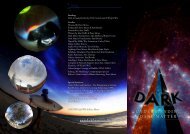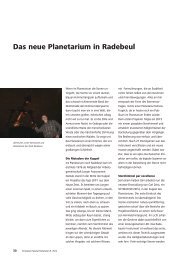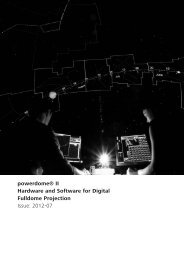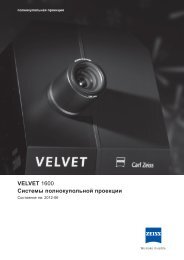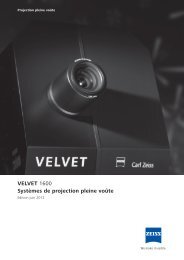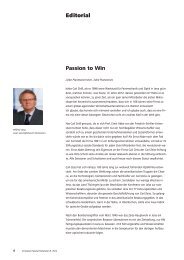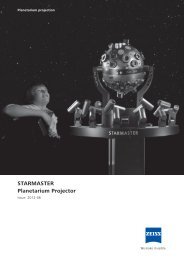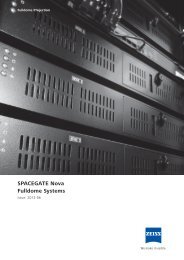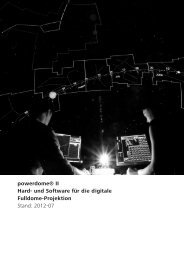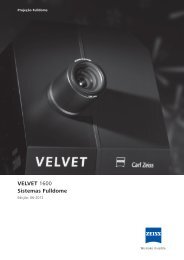Innovation Special Planetariums 9 - Carl Zeiss Planetariums
Innovation Special Planetariums 9 - Carl Zeiss Planetariums
Innovation Special Planetariums 9 - Carl Zeiss Planetariums
You also want an ePaper? Increase the reach of your titles
YUMPU automatically turns print PDFs into web optimized ePapers that Google loves.
First 2-channel Hybrid Planetarium in Europe<br />
Stefanie Neuhäuser, <strong>Carl</strong> <strong>Zeiss</strong><br />
The first Hybrid Planetarium comprising<br />
a 2-channel fulldome system and an<br />
opto-mechanical projection machine in<br />
Europe was put into operation in Italy in<br />
December 2011. In Cagliari, the largest<br />
city of Sardinia, <strong>Carl</strong> <strong>Zeiss</strong> installed the<br />
first SPACEGATE Nova fulldome system<br />
together with a SKYMASTER ZKP 4 star<br />
projector.<br />
SPACEGATE Nova designates a dome<br />
projection system into which <strong>Carl</strong> <strong>Zeiss</strong><br />
integrates selected commercially available<br />
projectors. At the Planetarium of<br />
Cagliari, two F32 projectors (projectiondesign)<br />
are arranged close to the star<br />
projector at the dome center. SKYMAS-<br />
TER ZKP 4 and SPACEGATE Nova work in<br />
perfect synchronism.<br />
Adrienne Ruhnau<br />
Der Maler Ruhnau, Drebach<br />
“Credentials”<br />
Il Planetario<br />
de L'Unione Sarda<br />
Piazza L'Unione Sarda<br />
09122 Cagliari<br />
ITALY<br />
planetario@unionesarda.it<br />
www.planetariounionesarda.it/<br />
ZEISS SKYMASTER ZKP 4<br />
powerdome®SPACEGATE Nova<br />
Opening: 2011<br />
Dome diameter: 10 m<br />
Refurbishment of Dome Surfaces in <strong>Planetariums</strong><br />
Renewing the paint coat of the perforated projection surface<br />
of a planetarium dome must ensure the necessary homogeneity<br />
and therefore calls for special knowledge and skill. The surface<br />
must be painstakingly cleaned, the perforations must not<br />
be clogged with paint, and sheet-metal edges require particular<br />
attention.<br />
A company in Drebach known as "der maler ruhnau" is specialized<br />
for spray-painting planetarium domes and works as a<br />
partner of <strong>Carl</strong> <strong>Zeiss</strong> AG.<br />
The company uses a special spraying method for dome surfaces.<br />
After cleaning with compressed air, paint is applied in<br />
several layers. The paints are free of any solvents and have<br />
been tested by <strong>Carl</strong> <strong>Zeiss</strong> for reflectance and gloss. The paint is<br />
sprayed on obliquely relative to the perforation, at a computed<br />
angle. The result is a neat, homogeneous coat system including<br />
the circumferential surfaces of the holes.<br />
During these jobs, the equipment in the planetarium must be<br />
protected against impacts and dust. Carpeting is covered with<br />
dust-proof sheeting. The workers at the dome surface are supported<br />
by telescoping working platforms or scaffolding.<br />
Reference jobs carried out by the company include the following:<br />
• <strong>Zeiss</strong> Planetarium of Drebach, Germany<br />
• Kassel Planetarium, Germany<br />
• <strong>Zeiss</strong> Planetarium Bochum, Germany<br />
• Planetarium minikosmos Lichtenstein, Germany<br />
• Kreuzlingen Planetarium, Switzerland<br />
• Brügge Planetarium, Belgium<br />
<strong>Innovation</strong> <strong>Special</strong> <strong>Planetariums</strong> 9, 2012<br />
21




